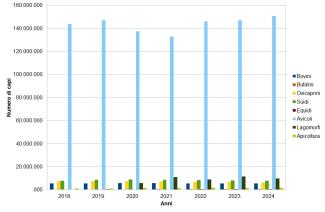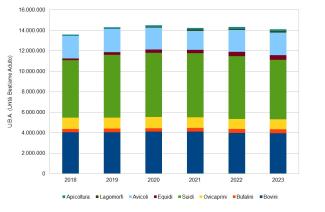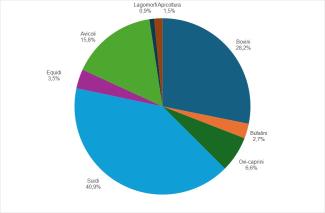Panel 1
Luca Campana
The information on the population of the main livestock species, extracted from the National Livestock Register (BDN) managed by the Ministry of Health through the National Service Centre (CSN) at the "G. Caporale" Institute in Teramo — which compiles data on livestock operators, holdings and individual animals, as reported by Veterinary Services and Breeders’ Associations — has been converted into LSU (Livestock Units) to allow for consistent assessment.
The recorded data indicate that in 2024 — the latest full year available for the main livestock species considered — there was an overall decrease in livestock numbers (expressed in Livestock Units - LSU) of 3.3% over the 2019–2024 period, and a 1.9% decline compared to 2023.
In detail, the largest percentage reduction in LSUs was observed in sheep and goat breeds, with a 16.7% decrease over the five-year period and a 6.4% drop in the most recent year.
The gradual decline in cattle numbers also continues (-3.9% over five years and -1.5% between 2023 and 2024), while buffalo numbers show a consistent increase (+9.1% over five years and +0.9% in the last year), confirming the trend toward replacement in livestock farming practices.
This trend appears to be driven by both the greater hardiness of the buffalo and recent European policy developments (such as the Common Agricultural Policy, the European Green Deal, and Regulation (EU) 2024/1991 – the so-called Nature Restoration Law), which support pasture-based livestock systems and the restoration of wetlands — environments particularly well-suited to buffalo farming. The current absence of production restrictions (e.g. “milk quotas”) on buffalo also contributes to this shift.
This indicator aims to assess the environmental pressure exerted by livestock farming activities of the main zootechnical species by analyzing the temporal evolution of their population sizes. It is assumed that such activities generate various pressures on the environment: on soils, through the input of manure and effluents or by causing compaction processes, thereby affecting the physical, chemical, and structural quality of soils; and on the atmosphere, through the emission of climate-altering gases (CO2, NH3, and CH4) resulting from the digestive processes of farmed animals and/or from aerobic fermentation during the storage of their manure.
Provide information on the national population size of the main livestock species of interest and their distribution by classes.
Relevant EU and National Legislation and Policy Frameworks on Livestock and Agriculture
- Regulation (EU) 2022/2379 of the European Parliament and of the Council of 23 November 2022 on agricultural input and output statistics, amending Commission Regulation (EC) No 617/2008, and repealing Regulations (EC) No 1165/2008, (EC) No 543/2009, (EC) No 1185/2009, and Council Directive 96/16/EC (relevant for the EEA).
- Council Regulation (EC) No 73/2009 of 19 January 2009 establishing common rules for direct support schemes under the Common Agricultural Policy (CAP) and amending related regulations.
- Regulation (EU) 2021/2115 of 2 December 2021 laying down rules on support for strategic plans under the CAP, financed by the European Agricultural Guarantee Fund (EAGF) and European Agricultural Fund for Rural Development (EAFRD), repealing Regulations (EU) No 1305/2013 and (EU) No 1307/2013.
- Decision (EU) 2022/591 on the 8th Environment Action Programme (8EAP) until 2030.
- European Green Deal Communication (COM/2019/640 final), outlining the EU’s strategy for sustainable growth and climate neutrality.
- Various national legislative decrees and regulations aligning Italian legislation with EU regulations on animal identification, traceability, and livestock management, including:
- Legislative Decrees Nos. 27/2021, 32/2021, 52/2018, 134/2022, 135/2022, among others;
- National decrees on animal registry management and emergency provisions related to agricultural organization and natural disaster responses.
Policy Objectives and Measures
The EU Environment Action Programmes (7EAP and proposed 8EAP) and Agenda 21 emphasize sustainable land use, biodiversity protection, and maintaining productivity. These goals are echoed in EU and national soil and water protection legislation.
To achieve these objectives, both the European Green Deal and the CAP 2023-2027 continue voluntary, conditional incentive schemes for operators supported by EAGF and EAFRD funds, which steer agricultural interventions.
Agriculture and rural areas are central to the Green Deal and CAP strategies, contributing to the Farm to Fork and Biodiversity strategies.
Planned interventions include:
- Market measures to stabilize farmers’ incomes via market management and direct payments (CAP first pillar);
- Competitiveness and rural development measures planned territorially (second pillar) through the National Strategic Plan (NSP) and regional Rural Development Programs (RDPs).
Key objectives are:
- Ensuring fair farm incomes;
- Increasing competitiveness;
- Improving farmers’ position in the food chain;
- Addressing climate change;
- Protecting the environment;
- Safeguarding landscape and biodiversity;
- Supporting generational renewal;
- Developing dynamic rural areas;
- Protecting food quality and health;
- Promoting knowledge and innovation.
Measures on Livestock Environmental Pressure
Environmental measures targeting livestock pressures are embedded within these Plans. Regional initiatives under the Rural Development Programs primarily include:
- Measure 14 – Sub-measure 14.01: Payments for animal welfare, focused on:
- Improving animal welfare;
- Reintroducing extensive livestock farming methods (e.g., summer grazing for cattle, outdoor rearing for pigs).
Panel 2
The indicator does not directly correlate the livestock population sizes by type (i.e., the Determinant) with either the quantity of emissions (CO₂ and effluents, i.e., the pressures), nor with the number of farms, their territorial size, the Utilized Agricultural Area (UAA) / Total Agricultural Area (TAA), or the overall national land area.
For this reason, the indicator, as currently proposed, does not accurately reflect the environmental pressures exerted by the livestock sector as a whole.
Overcoming the indicator concept by developing an algorithm that, by correlating the variables mentioned above, enables the computation of a composite pressure index.
Data quality assessment
Ministry of Health
National Livestock Register (BDN) of the Animal Identification and Registration System, established by the Ministry of Health at the National Reference Centre (CSN) of the "G. Caporale" Institute in Teramo (https://www.vetinfo.it/j6_statistiche/#/)
National level
2018-2024
Indicator assessment
Data collected from the National Livestock Database (BDN) report the number of bovine, buffalo, swine, ovine-caprine, and equine animals, as well as poultry, lagomorphs, and beehives/bee colonies present within national territory. These figures are recorded at least twice per year, on 30 June and 31 December. In some cases, such as poultry and lagomorphs, data collection occurs quarterly.
To allow for harmonised comparison across the various types of livestock production systems, all data on livestock numbers have been converted into Livestock Units (LU) using appropriate conversion coefficients.
The conversion factors between animal categories are primarily drawn from Annex V of Commission Regulation (EC) No 1974/2006 of 15 December 2006, laying down detailed rules for the application of Council Regulation (EC) No 1698/2005 on support for rural development by the European Agricultural Fund for Rural Development (EAFRD). Where not covered in the regulation, additional conversion coefficients were proposed by regional authorities under Regulation (EU) No 1305/2013 and Regulation (EU) No 1307/2013, as subsequently replaced by Regulation (EU) 2021/2115 of the European Parliament and of the Council of 2 December 2021, establishing rules on support for CAP Strategic Plans funded by the European Agricultural Guarantee Fund (EAGF) and the European Agricultural Fund for Rural Development (EAFRD).
According to the National Livestock Register (BDN – Ministry of Health), as of December 2024, Italy had 7.9 million pigs (accounting for 40.9% in terms of Livestock Units – LSU – relative to the total livestock population considered), over 5.3 million cattle (28.2% in LSU), 5.4 million sheep, and 0.9 million goats (see Figure 1, Figure 3 and Table 1).
The recorded data indicate that in 2024 — the latest full year available for the main livestock species considered — there was an overall decrease in livestock numbers (expressed in Livestock Units - LSU) of 3.3% over the 2019–2024 period, and a 1.9% decline compared to 2023.
In detail, the largest percentage reduction in LSUs was observed in sheep and goat breeds, with a 16.7% decrease over the five-year period and a 6.4% drop in the most recent year.
The gradual decline in cattle numbers also continues (-3.9% over five years and -1.5% between 2023 and 2024), while buffalo numbers show a consistent increase (+9.1% over five years and +0.9% in the last year), confirming the trend toward replacement in livestock farming practices.
This trend appears to be driven by both the greater hardiness of the buffalo and recent European policy developments (such as the Common Agricultural Policy, the European Green Deal, and Regulation (EU) 2024/1991 – the so-called Nature Restoration Law), which support pasture-based livestock systems and the restoration of wetlands — environments particularly well-suited to buffalo farming. The current absence of production restrictions (e.g. “milk quotas”) on buffalo also contributes to this shift.
Data
Table 1: National livestock population of the main farmed species converted into Livestock Units (LSU)
ISPRA processing based on data provided by the National Animal Registry (BDN) established by the Ministry of Health at the National Services Centre (CSN) of the "G. Caporale" Institute in Teramo.
Figure 2: National livestock population of the main farmed species converted into Livestock Units (LSU)
ISPRA processing based on data provided by the National Animal Registry (BDN) established by the Ministry of Health at the National Services Centre (CSN) of the "G. Caporale" Institute in Teramo.
Figure 3: Percentage composition of the main farmed species expressed in Livestock Units (LSU) – 2024
ISPRA processing based on data provided by the National Animal Registry (BDN) established by the Ministry of Health at the National Services Centre (CSN) of the "G. Caporale" Institute in Teramo.



In order to ensure data comparability, the livestock populations of different species were standardized using Livestock Units (LUs), based on the official conversion coefficients provided in the standard reference tables.